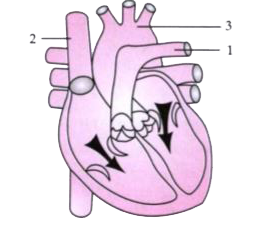Given below is a schematic diagram showing Mendel's Experiment on sweet pea plants having axial flowers with round seeds (AARR) and Terminal flowers with wrinkled seeds (aarr). Study the same and answer the questions that follow :

Give the phenotypes of progeny produced upon by the self pollination of progeny.
Step by step video & image solution for Given below is a schematic diagram showing Mendel's Experiment on sweet pea plants having axial flowers with round seeds (AARR) and Terminal flowers with wrinkled seeds (aarr). Study the same and answer the questions that follow : Give the phenotypes of F_2 progeny produced upon by the self pollination of F_1 progeny. by Biology experts to help you in doubts & scoring excellent marks in Class 10 exams.
Updated on:21/07/2023Topper's Solved these Questions
Similar Questions
Given below is a schematic diagram showing Mendel's Experiment on sweet pea plants having axial flowers with round seeds (AARR) and Terminal flowers with wrinkled seeds (aarr). Study the same and answer the questions that follow :

Give the phenotype of F1 progeny.
View SolutionGiven below is a schematic diagram showing Mendel's Experiment on sweet pea plants having axial flowers with round seeds (AARR) and Terminal flowers with wrinkled seeds (aarr). Study the same and answer the questions that follow :

Give the phenotypic ratio of F2 progeny.
View SolutionGiven below is a schematic diagram showing Mendel's Experiment on sweet pea plants having axial flowers with round seeds (AARR) and Terminal flowers with wrinkled seeds (aarr). Study the same and answer the questions that follow :

Name and explain the law induced by Mendel on the basis of the above observation.
View SolutionGiven below is an experimental setup to demonstrate a particular tropic movement in germinating seeds. Study the diagram and answer the questions that follow :

What is Thigmotropism 2 Give one example,
View SolutionGiven below is an experimental setup to demonstrate a particular tropic movement in germinating seeds. Study the diagram and answer the questions that follow :

Label the parts 1 and 2.
View SolutionIn an experiment on pea plant, pure plants with yellow round seeds (YYRR) were crossed with plants producing green wrinkled seeds (yyrr). What will be phenotypic ratio of F1 progeny ?
View SolutionIn Mendel's experiments with garden pea, round seed shape (RR) was dominant over wrinkled seeds (rr), yellow cotyledon (YY) was dominant over green cotyledon (yy). What are the expected phenotypes in the F2-generation of the cross RRYY × rryy ?
View Solution(a) Dihybrid cross between two garden pea plant one homozygous tall with round seeds and the other with wrinkled seeds was carried.
(i) Write the genotype and phenotype of the F1 progeny obtained from this cross.
(ii) Give the different types of gametes of the F1 progeny.
(iii) Write the phenotypes and its ratios of the F2 generation obtained in this cross along with the explanation provided by Mendel.
(b) How were the observations of F2 progeny of dihybrid crosses in Philosophical by Morgan different from that of Mendel carried in Pea plants ? Explain giving reasons.
View SolutionThe diagram given below represents the human heart in one phase of its functional activities. Study the same and answer the questions that follow :

Draw well labelled diagrams of part 1 and 2 to show the structural differences between them.
View SolutionA homozygous pea plant with round seed coat and yellow cotyledons is crossed with another homozygous pea plant having wrinkled seed coat and green cotyledons.
Give the types of gametes produced by plants of F1 -generation.
View Solution
